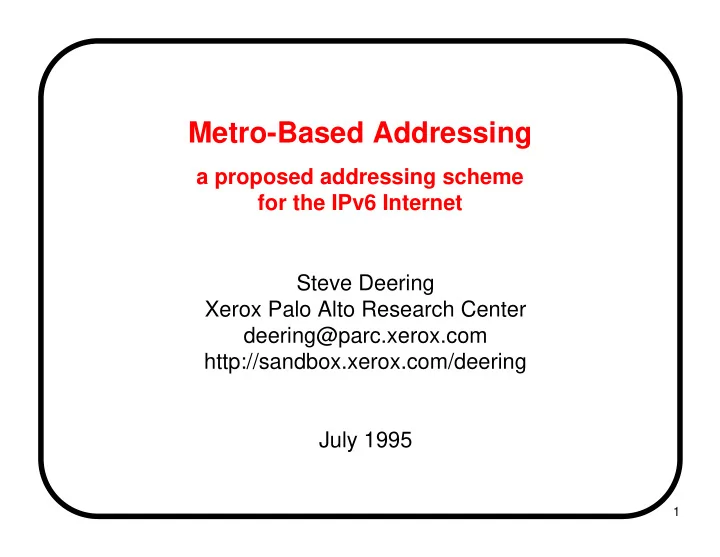

Metro-Based Addressing a proposed addressing scheme for the IPv6 Internet Steve Deering Xerox Palo Alto Research Center deering@parc.xerox.com http://sandbox.xerox.com/deering July 1995 1
Design Goals • scalable routing » no more than a few hundred entries per routing table • no renumbering when changing providers (among providers serving same locale) » minimize disincentive to change providers » avoid need for new host technology 2
Metro Address Structure FP country metro site intra-site part FP format prefix metro geographical region centered on major metropolitan area site office site, private residence, campus, etc. (up to millions per metro) note: no provider ID anywhere in address 3
Illustrative Example P1 P1 P2 P3 P3 metro A metro B 4
Inter-Metro Routing • conventional longest-match on country + metro • bilateral agreements for inter-metro carriage • a provider may serve any number of sites in any number of metros in any number of countries 5
Intra-Metro Routing • all providers serving a metro must be connected within that metro (either directly or indirectly) • simplest form of interconnect is the MIX (metropolitan internet exchange) » high-speed LAN or a layer-2 MAN service » can use multiple, redundant MIXes for robustness & load-splitting » operated as joint venture of providers or by a third party, with fair and equal access rules 6
Intra-Metro Routing (cont.) to support up to millions of sites, a provider’s intra- metro routers do 2-step route lookup: (1) look up dest. site in customer database to learn site-connected router (2) if found, look up site-connected router in conventional routing table, and forward else forward towards nearest MIX (do normal caching to avoid lookups on every pkt) 7
The Customer Database • has to be maintained by a provider anyway, for billing, maintenance, etc. purposes • updates distributed to all intra-metro routers once a day => can change providers within 24 hours • distributed to a provider’s local routers only 8
Routing at the MIX a couple of possibilities: » multicast query across the MIX; cache answer » pre-exchange of site databases 9
Metro Address Assignment • metro prefixes assigned to metros by ISOC-IANA (possibly delegated to national ISOC chapters) • blocks of site prefixes distributed to intra-metro providers for assignment to new sites • site prefix stays with site when it changes providers 10
Provider Selection (Packet-by-Packet) outbound packets: » by source hosts, using source routing or encaps » by site boundary routers, using encaps ( plus optional source routing) inbound packets: » by info placed in DNS, or » by reply info included in packets 11
Stuff I Don’t Have Time to Explain Today • rerouting around failed connections to sites, for multi-homed sites • addressing and routing within multi-metro private networks an internet draft is in preparation… 12
Open Issues • how to achieve required intra-metro connectedness? » market demand? » contract between ISOC and providers, placing conditions on use of metro address prefixes? » note: can co-exist with provider-based addressing • can multiple, competing MIXes be supported? 13
The Downside • need for provider connectedness within each metro ( eventually ) can phase in MIXes by having one MIX serve multiple nearby metros until density warrants separate MIXes, but to avoid future renumbering, must assign addresses based om metro, not MIX • need for two-step route lookup within metros ( eventually ) until provider has many thousands of customers within a single metro, can use existing routing technology 14
The Upside • can do scalable routing without site renumbering • a number of secondary benefits: » usually only one address per interface » “non-surprising” routing (short deliver paths => low delay, possibly higher throughput) » can determine rough distance (~=> delay) between addresses by examination » hard to discriminate against providers » simplified inter-provider coordination 15
a PostScript copy of these slides may be fetched from: ftp://parcftp.xerox.com/pub/net-research/metro-addr-slides-jul95.ps 16
Recommend
More recommend